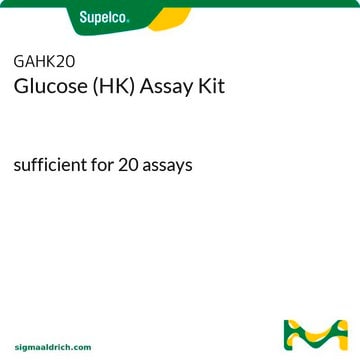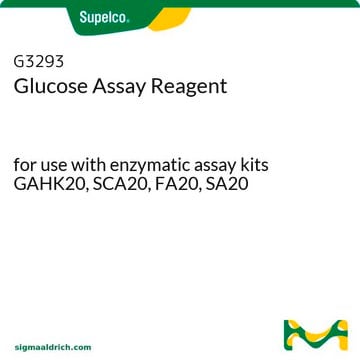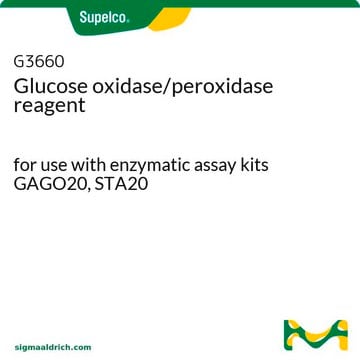Products may be shipped at a different temperature than the recommended long-term storage temperature. If the product quality is sensitive to short-term exposure to conditions other than the recommended long-term storage, it will be shipped on wet or dry-ice. If the product quality is NOT affected by short-term exposure to conditions other than the recommended long-term storage, it will be shipped at ambient temperature. As shipping routes are configured for minimum transit times, shipping at ambient temperature helps control shipping costs for our customers. For more information, please refer to the Storage and Transport Conditions document: https://www.sigmaaldrich.com/deepweb/assets/sigmaaldrich/marketing/global/documents/316/622/storage-transport-conditions-mk.pdf
GAGO20
Glucose (GO) Assay Kit
sufficient for 20 assays
Sinónimos:
Glucose Quantification Kit
Seleccione un Tamaño
138,00 €
Seleccione un Tamaño
About This Item
138,00 €
Productos recomendados
uso
sufficient for 20 assays
aplicaciones
food and beverages
general analytical
temp. de almacenamiento
2-8°C
Categorías relacionadas
Aplicación
Idoneidad
Solo componentes del kit
- o-dianisidine reagent 1 mL/vial
- glucose oxidase/peroxidase reagent 1 capsule
- glucose standard .5 mL
Producto relacionado
Palabra de señalización
Danger
Frases de peligro
Clasificaciones de peligro
Acute Tox. 4 Oral - Carc. 1B - Eye Dam. 1 - Skin Corr. 1
Código de clase de almacenamiento
6.1C - Combustible acute toxic Cat.3 / toxic compounds or compounds which causing chronic effects
Clase de riesgo para el agua (WGK)
WGK 3
Elija entre una de las versiones más recientes:
Certificados de análisis (COA)
¿No ve la versión correcta?
Si necesita una versión concreta, puede buscar un certificado específico por el número de lote.
¿Ya tiene este producto?
Encuentre la documentación para los productos que ha comprado recientemente en la Biblioteca de documentos.
-
How is shipping temperature determined? And how is it related to the product storage temperature?
1 respuesta-
¿Le ha resultado útil?
-
-
How can I determine the shelf life / expiration / retest date of this product?
1 respuesta-
If this product has an expiration or retest date, it will be shown on the Certificate of Analysis (COA, CofA). If there is no retest or expiration date listed on the product's COA, we do not have suitable stability data to determine a shelf life. For these products, the only date on the COA will be the release date; a retest, expiration, or use-by-date will not be displayed.
For all products, we recommend handling per defined conditions as printed in our product literature and website product descriptions. We recommend that products should be routinely inspected by customers to ensure they perform as expected.
For products without retest or expiration dates, our standard warranty of 1 year from the date of shipment is applicable.
For more information, please refer to the Product Dating Information document: https://www.sigmaaldrich.com/deepweb/assets/sigmaaldrich/marketing/global/documents/449/386/product-dating-information-mk.pdf¿Le ha resultado útil?
-
-
Why would liquid samples need to be diluted to 20-80 ug/mL? I'm hoping to be able to use this kit to measure glucose levels in serum that should be between 5 - 30 mmol/L. Would this work?
1 respuesta-
Unfortunately, no, this kit is not suitable for concentrations of 5-30 mmol/L, which equates to 900-5400 mg/L. This concentration is far above the detection range and would offer poor results. The detection range of this kit is approximately 10-100 ug/ml and sample dilution is required for accurate, repeatable results. Measuring samples outside of this range is not recommended.
¿Le ha resultado útil?
-
-
Can I use this kit for colorimetric tests?
1 respuesta-
Yes, this kit is suitable for use with any colorimeter capable of measuring absorbance at 540 nm. Please see the link below to review the product datasheet:
https://www.sigmaaldrich.com/deepweb/assets/sigmaaldrich/product/documents/516/298/gago20bul.pdf¿Le ha resultado útil?
-
-
Is it possible to adapt the GAGO20 Glucose (GO) Assay Kit to a 96-well plate?
1 respuesta-
Researchers have documented an adaptation of the kit to a 96-well assay format as follows.
To prepare glucose standards, 16 µl of 1 mg/ml glucose should be diluted with 84 µl PBS to achieve a 100 µl final volume for a 0.16 mg/ml standard. Four 2-fold serial dilutions into PBS (50 µl 0.16 mg/ml + 50 µl PBS for 0.08 mg/ml standard, etc.) should be done to generate 0.01, 0.02, 0.04, 0.08, and 0.16 mg/ml glucose standards. These assays are linear from 0.01 to 0.16 mg/ml glucose. Glucose stock solutions can be stored at −20°C or 4°C.
Then, 30 µl of glucose standards and a PBS blank should be added to the first row of a clear-bottom 96 well plate. In the next row, 30 µl of each sample should be added into an individual well after diluting them 1:4–1:8 with PBS.For Glucose Oxidase-based Glucose assay:
• Add 100 µl of GO reagent (Sigma; GAGO-20) to each well with a multichannel pipette.
• Seal the wells with parafilm to prevent evaporation and incubate the plate at 37°C for 30–60 min.
• Stop the reaction by adding 100 µl of 12 N H2SO4 (the samples should visibly change color from yellow/orange to pink).
• Centrifuge the plate in an appropriate swing-bucket rotor to clear condensate from the sides of the wells and to remove any air bubbles present in the samples.
• Use a plate reader to measure absorbance at 540 nm.
• Determine the free glucose concentration by comparing the free glucose measurements for each sample to the glucose standard curve.¿Le ha resultado útil?
-
-
Can I scale down the reaction volumes 20-25 times lower than what is specified in the protocol? So instead of using 1ml of sample, 2 ml of assay reagent, and 2ml of sulfuric acid, use 50ul, 100ul and 100ul of each step and react?
1 respuesta-
This kit has been optimized for use at the volumes given in the protocol. The suitability of using smaller volumes in a tube format would have to be determined by the end user and is not recommended. However, other researchers have published an adaptation of the kit to a 96-well assay format which utilizes similar volumes. Please note that this process has not been validated. The 96-well plate protocol can be reviewed below.
Prepare glucose standards: Dilute 16 µl of 1 mg/ml glucose with 84 µl PBS (100 µl final volume) for 0.16 mg/ml standard. Do four 2-fold serial dilutions into PBS (50 µl 0.16 mg/ml + 50 µl PBS for 0.08 mg/ml standard, etc.) to generate 0.01, 0.02, 0.04, 0.08, and 0.16 mg/ml glucose standards. These assays are linear from 0.01 to 0.16 mg/ml glucose. Glucose stock solutions can be stored at −20°C or 4°C.
Add 30 µl of glucose standards and a PBS blank to the first row of a clear-bottom 96 well plate. In the next row, add 30 µl of each sample into an individual well (after diluting them 1:4–1:8 with PBS).
9a)For Glucose Oxidase-based Glucose assay:
Add 100 µl of GO reagent (Sigma; GAGO-20) to each well with a multichannel pipette. Seal the wells with parafilm to prevent evaporation and incubate the plate at 37°C for 30–60 min. Stop the reaction by adding 100 µl of 12 N H2SO4 (the samples should visibly change color from yellow/orange to pink). Centrifuge the plate in an appropriate swing-bucket rotor to clear condensate from the sides of the wells and to remove any air bubbles present in the samples. Use a plate reader to measure absorbance at 540 nm. Determine the free glucose concentration by comparing the free glucose measurements for each sample to the glucose standard curve.Please see this article for more information: https://www.ncbi.nlm.nih.gov/pmc/articles/PMC4048761/
¿Le ha resultado útil?
-
-
Can I perform the reaction on polystyrene based plastic tube? ie do the reaction directly on 96-well clear plate
1 respuesta-
Researchers have published an adaptation of the kit to a 96-well assay format as follows. Please note that this process has not been validated.
Prepare glucose standards: Dilute 16 µl of 1 mg/ml glucose with 84 µl PBS (100 µl final volume) for 0.16 mg/ml standard. Do four 2-fold serial dilutions into PBS (50 µl 0.16 mg/ml + 50 µl PBS for 0.08 mg/ml standard, etc.) to generate 0.01, 0.02, 0.04, 0.08, and 0.16 mg/ml glucose standards. These assays are linear from 0.01 to 0.16 mg/ml glucose. Glucose stock solutions can be stored at −20°C or 4°C.
Add 30 µl of glucose standards and a PBS blank to the first row of a clear-bottom 96 well plate. In the next row, add 30 µl of each sample into an individual well (after diluting them 1:4–1:8 with PBS).
9a)For Glucose Oxidase-based Glucose assay:
Add 100 µl of GO reagent (Sigma; GAGO-20) to each well with a multichannel pipette. Seal the wells with parafilm to prevent evaporation and incubate the plate at 37°C for 30–60 min. Stop the reaction by adding 100 µl of 12 N H2SO4 (the samples should visibly change color from yellow/orange to pink). Centrifuge the plate in an appropriate swing-bucket rotor to clear condensate from the sides of the wells and remove any air bubbles present in the samples. Use a plate reader to measure absorbance at 540 nm. Determine the free glucose concentration by comparing the free glucose measurements for each sample to the glucose standard curve.Please see this article for more information: https://www.ncbi.nlm.nih.gov/pmc/articles/PMC4048761/
¿Le ha resultado útil?
-
-
How would you deproteinate and decolorize serum sample to be compatible with the GAGO20 assay kit?
1 respuesta-
There are a number of ways to deproteinize serum. Most classical methods use acids or solvents to precipitate proteins followed by centrifugation. One example is given below:
Use perchloric acid (10% v/v) in a volume equal to the sample, mix well, and centrifuge. Remove the supernatant and neutralize it with KOH (20% w/v). Allow to stand for 10 minutes in an ice bath and centrifuge. The sample (supernatant) can then be run in the assay.Another option is filtration through a 10 kDa MWCO spin filter. The spin filter that can be used for this purpose is SKU UFC5010.
https://www.sigmaaldrich.com/US/en/product/mm/ufc5010Note that high hemoglobin levels (caused by hemolysis upon collection) may also contribute to the colorization of serum and plasma, however upon dilution, it should not be a factor with GAGO20.
See the link below to a publication that reviews other methods of deproteinization:
https://www.longdom.org/open-access/deproteination-of-blood-plasma-in-human-body-for-serum-analysis-93551.html¿Le ha resultado útil?
-
-
Can Product GAGO20, Glucose (GO) Assay Kit, be used in a 96-well plate format?
1 respuesta-
Sigma Aldrich has not performed this in a 96-well plate format. However if a method has have not tried this. If you have developed a method in a 96-well format, Sigma Aldrich would be happy to know about this.
¿Le ha resultado útil?
-
-
What is the difference between the GAGO20 and GAHK20 Glucose (GO) Assay Kits?
1 respuesta-
The kits use different enzymes. GAGO20 uses glucose oxidase and peroxidase, while GAHK20 uses hexokinase. Furthermore, the final reaction products are monitored at different wavelengths, 540 nm (GAGO20) and 340 nm (GAHK20).
¿Le ha resultado útil?
-
Filtros activos
Nuestro equipo de científicos tiene experiencia en todas las áreas de investigación: Ciencias de la vida, Ciencia de los materiales, Síntesis química, Cromatografía, Analítica y muchas otras.
Póngase en contacto con el Servicio técnico








